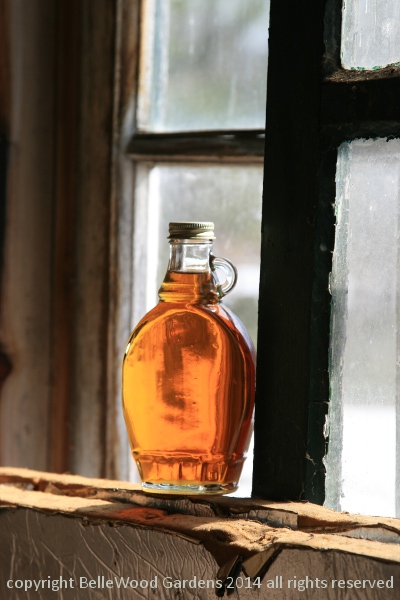
.
If you have any comments, observations, or questions about what you read here, remember you can always Contact Me
All content included on this site such as text, graphics and images is protected by U.S and international copyright law.
The compilation of all content on this site is the exclusive property of the site copyright holder.

It's called a sugarbush, a woodlot with enough sugar maple trees to be worthwhile to tap for syrup. Here at the Howell Living History Farm they tap about 250 trees. Some are tapped as part of a presentation to school groups. These are done the old fashioned way, with spiles dripping into buckets. Each group taps a half dozen trees or so, adding up to about 100 buckets this year.

The remaining trees are done with tubing to collect the sap and bring it to large storage tanks. That's actually more convenient than the buckets hung off a tree that require frequent monitoring.

Jack and Chester are hitched to a sledge, its runners gliding over the solid snowcover over the field. Today they're actually giving rides for the visitors. The weather has been so cold, too cold for the sap to rise. Otherwise they might be hitched up and the sled used to transport large milk cans, scoured out and filled with the sap from the tree-hung buckets.

There's a (relatively speaking) smaller evaporator, outdoors near the barns. It's a delightful setup for public presentations - sap on the boil, someone explaining about how you get from sap (40 gallons of it) to syrup (one gallon.) Quite a reduction, boiling off all that water to concentrate the sweetness. That's why it is a good idea to do most of the operation outdoors where the steam can sweetly dissipate and not steam the wallpaper off the kitchen wall.

Temperature is critical. The desired point is reached at 7 degrees above the boiling point of water, or 219 degrees Fahrenheit. Backyard maple syrup maker often pull the partially condensed syrup off the evaporator and finish it in a large pot on the kitchen stove, or using a turkey fryer operation. That allows better control than trying to handle a large flat pan full of hot syrup that can quickly pass beyond the correct temperature / syrup point. I was shown a cake of "maple ash" - black, carbonized stuff that a novice had go over in just minutes.
In addition to the smaller outdoor evaporator there's a larger unit in the sugar shack. Small for a commercial operation, it is a useful size here at the farm. Collected sap is pumped up to a cistern on the upper floor, from which it trickles down into the evaporator. The pan has baffles, to keep the sap moving and avoid hot spots.

Unlike commercial operations which, today, often use propane, both of the farm's evaporators are still fueled with wood.
The sugar shack is also a place for visitors to come, watch the operation, hear an explanation, ask their questions.

As well, there's a nice display of commercial maple syrup in tins and maple butter in a jar,

maple syrup in plastic jugs and a box of maple sugar,

and in glass. Some of the bottles are plain, others are fancy, specialty shapes.

Winter is winding down. I've never been so happy to see mud. Just a few weeks to the equinox and Spring's official arrival (at least according to the calendar.) Regardless, a practical, phenomenological sign is the tapping of the maple trees

which is indeed a sweet end to winter.
Back to Top
Back to March 2014